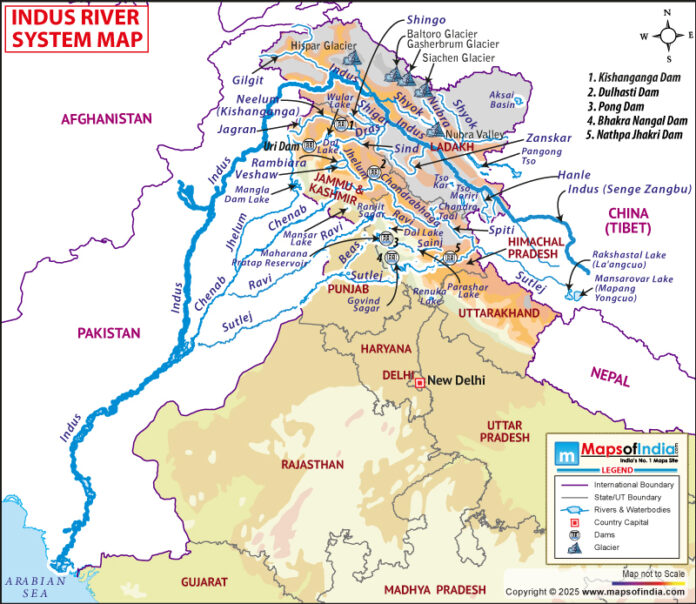Developed over decades of wars, political upheavals and mutual suspicion, the Indus Water Treaty (IWT) has been one of the rare sources of stability between India and Pakistan. The treaty, which was signed in 1960, was described as a breakthrough in the sphere of water diplomacy and split the use of the Indus River system between the two countries, guaranteeing a certain amount of collaboration in the otherwise conflict-ridden area.
But this arrangement that has existed for decades is jeopardized after India decided to withdraw its share in the treaty recently. A remnant of practicals and a beacon of peace is now the subject of geopolitical wrangling, anxiety of environmental concern and conflict amid diplomacy. The move would represent an important pivot, one that has already been on shaky ground, in the South Asia region, namely, to shift the vantage point on a peace deal to one of pressure.
A Brief Recap of the Indus Water Treaty
The Indus River system is among the largest in the world, and it originates in Tibet, passes through India and finally lands in Pakistan before pouring into the Arabian Sea. The Indus Water Treaty also declared the three eastern rivers, including Ravi, Beas, and Sutlej, to India and the three western rivers, including Indus, Jhelum, and Chenab, to Pakistan.
Although India was allowed to utilize the western rivers for non-consumptive aspects such as the production of hydropower, the agreement, in essence, allocated Pakistan power over 80 per cent of the water volume of the river system. Although this turned out as an unequal division, the treaty was still regarded as a success, partly because it could survive several conflicts between the two nations.
Why the Suspension Happened
India’s decision to suspend the treaty stems from a combination of political, strategic, and security considerations. Growing tensions along the Line of Control, repeated cross-border incidents, and a deepening distrust have made the government re-evaluate all bilateral arrangements, including the Indus Water Treaty.
From New Delhi’s perspective, the treaty has limited India’s rights over its rivers in the western basin, even as Pakistan has raised objections to projects India undertakes within its permissible share. Recent disputes over hydropower projects like Kishanganga and Ratle have only intensified the friction. The suspension is thus seen not only as a strategic warning but also as an attempt to reclaim leverage.
Diplomatic Fallout
The direct effect of giving up the treaty is the development of increased diplomatic tension. To Pakistan, the Indus Water Treaty has served as the lifeline, which has helped the country in growing crops, running industries and living daily in the country that is largely arid. Any disturbance is a direct threat to its water security that, in its turn, can cause political instability.
The migration will probably put the situation in the international spotlight. Pakistan can go to international locations like the United Nations or appeal to friendly countries. Although India has maintained that the treaty is bilateral, the threat of international oppression and isolation of India is not to be underscored.
Impact on Water Security
Water shortage is already an impending crisis in South Asia. The population growth and urbanization of India and Pakistan are increasing very fast, and climate change is having an impact on the water flows of the rivers. The cessation of the Indus Water Treaty increases uncertainty around actions that may be taken to address the scarcity unilaterally, including dam construction, water diversion, or diminished releases, that may exacerbate scarcity downstream.
In the case of Pakistan, where the economy is largely dependent on agriculture, a shift in the amount of available water may translate to loss of crop production, food insecurity and economic strains. Expanding control becomes a short-term strategic advantage to India, but the outcome may also lead to international condemnation in case of excessive humanitarian cost beyond the border.
Economic Ramifications
The financial impact of such suspension may be serious to both countries. Families in Pakistan would be directly affected by a decrease in water supply to their farming activities, hence their exports such as rice and cotton. The impact might be introverted with massive losses to the farmers, resulting in unrest in the rural setting.
Elsewhere, the collapse of the dams in India may open the doors to even grander hydropower and irrigation schemes in Jammu-Kashmir that have the potential to stimulate local economies. But it might be costly to construct large-scale infrastructure fast, and the green impact might challenge the good of the future.
Environmental and Climate Concerns
The Indus River system already faces pressure due to the reduction in size of Glaciers, unpredictable rainfall patterns and the increase in temperature. Ecological impacts of any political decision that changes the natural course of flow of these rivers are irreversible. This can lead to degradation of wetlands and changes in fish movement, and cause changes in the natural variety in the Indus delta because of reduced downstream flows.
In addition, the risk of flooding in times of a monsoon season or the risk of drought in times of a dry season may intensify as sudden or unilateral transitions in water administration can hurt the communities living on both sides of the border.
Risk of Water Wars
It might be very melodramatic to call them water wars, but it is true that when water conflicts are mixed with political enmity, they can deteriorate rather quickly. Suspension of the Indus Water Treaty takes away one of the important safeguards that have, over the last 60 years, maintained the distinction between water and military tensions.
The lack of dispute resolution mechanisms in the treaty would make even small disputes of dam height, dam flow measurement, and seasonal releases develop into other confrontations. This is a danger that no one can risk in a part of the world where territorial wrangles, nuclear arms, and unstable politics are the order of the day.
Possible Paths Forward
Suspension of the Indus Water Treaty is not the suspension of all cooperation. Some possible routes might turn out to be the following:
- Renegotiation of Terms – India and Pakistan may take the moment to renegotiate the treaty, which takes into consideration the modern-day reality, such as climate change, modern water measurement technology and the fair principle of usage.
- Third-Party Mediation – Although this may be controversial in terms of politics, it might be possible to rebuild dialogue through third-party mediation by an international body.
- Phased Engagement – It is possible that both parties can come to some short-lived arrangements of sharing water as pending political concerns are resolved.
- Integrated Basin Management – Even though scientific data-sharing in the Indus basin is highly problematic, with both countries having a joint approach to it, in the long term, it may prove beneficial to both nations.
Conclusion: A Critical Juncture in River Diplomacy
The Indus water treaty was not merely about the division of water, but was an exception to all the ups and downs in the India-Pakistan relationship. The decision to suspend the treaty has indicated that India is also willing to adopt water as a strategic tool, and this might change the politico-geographical configuration of South Asia.
These changes in the sphere of the relations between the two countries will result in the renegotiated, modernized agreement, or the new stage in the estrangement between the two countries, basically depending upon the readiness of the leaders to reach a compromise between strategic interests and the realities of humanitarian and environmental issues. The only definite thing is the fact that the Indus River will keep on its course; however, it is a matter of political will whether it is a bridge or a battlefield now.




